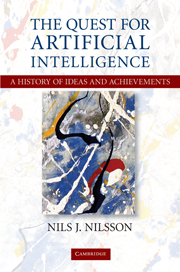Book contents
- Frontmatter
- Contents
- Preface
- PART I BEGINNINGS
- PART II EARLY EXPLORATIONS: 1950S AND 1960S
- PART III EFFLORESCENCE: MID-1960S TO MID-1970S
- 9 Computer Vision
- 10 “Hand-Eye” Research
- 11 Knowledge Representation and Reasoning
- 12 Mobile Robots
- 13 Progress in Natural Language Processing
- 14 Game Playing
- 15 The Dendral Project
- 16 Conferences, Books, and Funding
- PART IV APPLICATIONS AND SPECIALIZATIONS: 1970s TO EARLY 1980s
- PART V “NEW-GENERATION” PROJECT
- PART VI ENTR'ACTE
- PART VII THE GROWING ARMAMENTARIUM: FROM THE 1980s ONWARD
- PART VIII MODERN AI: TODAY AND TOMORROW
- Index
- Plate section
11 - Knowledge Representation and Reasoning
Published online by Cambridge University Press: 05 August 2013
- Frontmatter
- Contents
- Preface
- PART I BEGINNINGS
- PART II EARLY EXPLORATIONS: 1950S AND 1960S
- PART III EFFLORESCENCE: MID-1960S TO MID-1970S
- 9 Computer Vision
- 10 “Hand-Eye” Research
- 11 Knowledge Representation and Reasoning
- 12 Mobile Robots
- 13 Progress in Natural Language Processing
- 14 Game Playing
- 15 The Dendral Project
- 16 Conferences, Books, and Funding
- PART IV APPLICATIONS AND SPECIALIZATIONS: 1970s TO EARLY 1980s
- PART V “NEW-GENERATION” PROJECT
- PART VI ENTR'ACTE
- PART VII THE GROWING ARMAMENTARIUM: FROM THE 1980s ONWARD
- PART VIII MODERN AI: TODAY AND TOMORROW
- Index
- Plate section
Summary
For a system to be intelligent, it must have knowledge about its world and the means to draw conclusions from, or at least act on, that knowledge. Humans and machines alike therefore must have ways to represent this needed knowledge in internal structures, whether encoded in protein or silicon. Cognitive scientists and AI researchers distinguish between two main ways in which knowledge is represented: procedural and declarative. In animals, the knowledge needed to perform a skilled action, such as hitting a tennis ball, is called procedural because it is encoded directly in the neural circuits that coordinate and control that specific action. Analogously, automatic landing systems in aircraft contain within their control programs procedural knowledge about flight paths, landing speeds, aircraft dynamics, and so on. In contrast, when we respond to a question, such as “How old are you?,” we answer with a declarative sentence, such as “I am twenty-four years old.” Any knowledge that is most naturally represented by a declarative sentence is called declarative.
In AI research (and in computer science generally), procedural knowledge is represented directly in the programs that use that knowledge, whereas declarative knowledge is represented in symbolic structures that are more-or-less separate from the many different programs that might use the information in those structures. Examples of declarative-knowledge symbol structures are those that encode logical statements (such as those McCarthy advocated for representing world knowledge) and those that encode semantic networks (such as those of Raphael or Quillian). Typically, procedural representations, specialized as they are to particular tasks, are more efficient (when performing those tasks), whereas declarative ones, which can be used by a variety of different programs, are more generally useful.
- Type
- Chapter
- Information
- The Quest for Artificial Intelligence , pp. 149 - 161Publisher: Cambridge University PressPrint publication year: 2009



